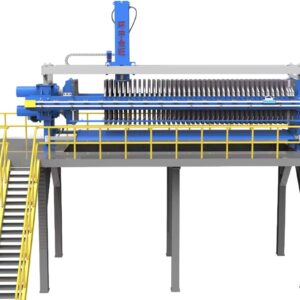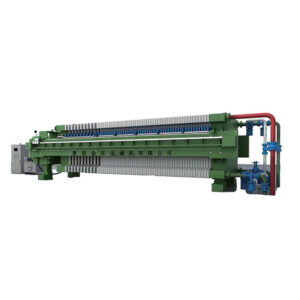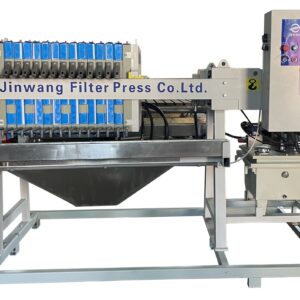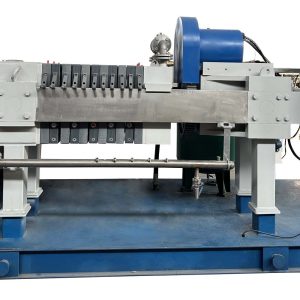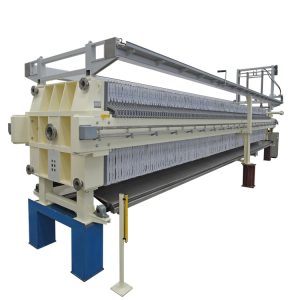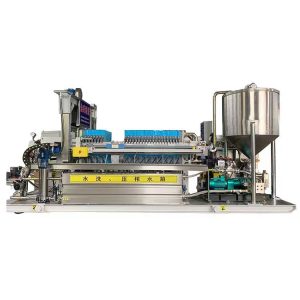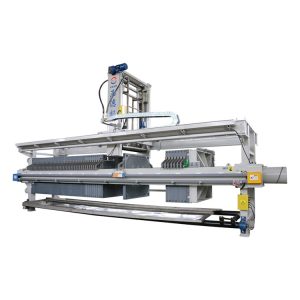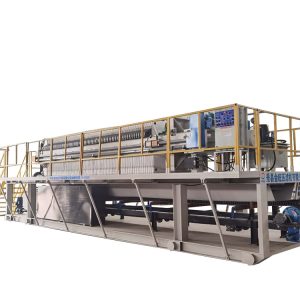JINWANG FILTER PRESS,
FLEXIBLY UPGRADEABLE FILTER PRESS SYSTEMS
Under the guidance of the concentric diversification strategy, Jingxian Jinwang Filter Press Co., Ltd. has formed eight series of products with filtration and separation machinery as the core, namely: manual type, mechanical type, hydraulic type, program-controlled automatic type, and quick-opening diaphragm type. , high-suspension beam type, automatic flushing type, automatic filter plate rapping type, the eight series of products both complement and support each other and are relatively independent. The product production chain has been continuously lengthened and improved, and the overall strength of the company has been greatly improved.
What is a filter press?
The filter press is a commonly used industrial equipment used for solid filtration in the solid-liquid separation process.
It mainly consists of a frame, filter plate, compression system and electrical control cabinet.Filter presses have a wide range of uses, and their products are used in coal, mining power, oil mining and refining, chemical industry, environmental protection, metallurgy, pigments, dyes, medicine, food and beverages and other industries. It can be used in solid-liquid separation, solid-liquid filtration, solid-liquid extraction and other processes to help companies achieve efficient production and resource utilization. Its working principle is to separate solid particles and liquid by applying a certain amount of pressure.
The filter press has the advantages of simple structure, convenient operation, large processing capacity, and good filtration effect. It can efficiently separate solids and liquids, improve production efficiency and reduce resource waste. Filter presses play an important role in industrial production and are of great significance for improving product quality and protecting the environment.
The structure of a filter press usually includes the following important parts:
1. Filter chamber: The filter chamber is the main component of the filter press, where the solid-liquid separation process takes place. It usually consists of a set of filter plates and filter cloth to form a solid filter chamber.
2. Pressing system: The pressing system is used to apply mechanical pressure to discharge the liquid in the mixture through the filter cloth to separate solids and liquids.
3. Feeding system: The feeding system is used to transport the mixture into the filter chamber. Usually includes delivery pipes, rotary valves, etc. to ensure that the mixture is evenly distributed in the filter chamber.
4. Slag discharge system: The slag discharge system is used to discharge the separated solids from the filter chamber. This can be done by vibrating equipment, pneumatics or manual operation.
5. Liquid collection system: The liquid collection system is used to collect the clean liquid discharged through the filter cloth. This allows liquid reuse or treatment after solid-liquid separation.
6. Control system: The control system is used to control and monitor the operating status of the filter press, including pressure adjustment, feed speed, slag discharge frequency and other parameters.
The above is the basic structure of a general filter press. Different types and specifications of filter presses may have some differences.
How a filter press works
Step 1: Press the filter plate tightly
Operate the hydraulic system to move the tail plate toward the head plate and tighten all filter plates between the head plate and the tail plate. As a result, a hollow sealed filter chamber is formed between adjacent filter plates.
Step 2: Press filtration process
The feed pump transports the mud from the feed hole of the tail plate to the filter chamber. When the filter chamber is filled with mud, the filter press process begins, and the mud is separated from solid and liquid with the help of the pressure of the feed pump.
In the early stage of filter press, the thickness of the mud cake in the filter chamber is not large, the resistance of the filter cake is small, and the dehydration speed is fast. Usually, a low-lift, large-flow pump is used at this time. As the thickness of the filter cake increases and the resistance increases, the filter press speed decreases. At this time, a pump with high lift and small flow rate should be used. The time required for the filter press process is determined according to the filtration characteristics and process requirements of the mud. When the specified filter press time is reached, the feeding is stopped and the filter press process is completed.
Step 3: Loosen the filter plate
Manipulate the hydraulic system to return the head plate to its original position.
Step 4: Unloading the filter plate
The transmission chain on the transmission and opening device successively pulls the filter plates apart, and the filter cake falls off by its own weight and is transported away by the lower conveyor.
The decisive factors for the correct filtration method of the filter press mainly include the following points:
- Filter media selection
- Filter pressure control
- Filter time control
- Filtration temperature control
- Maintenance of filter machines



